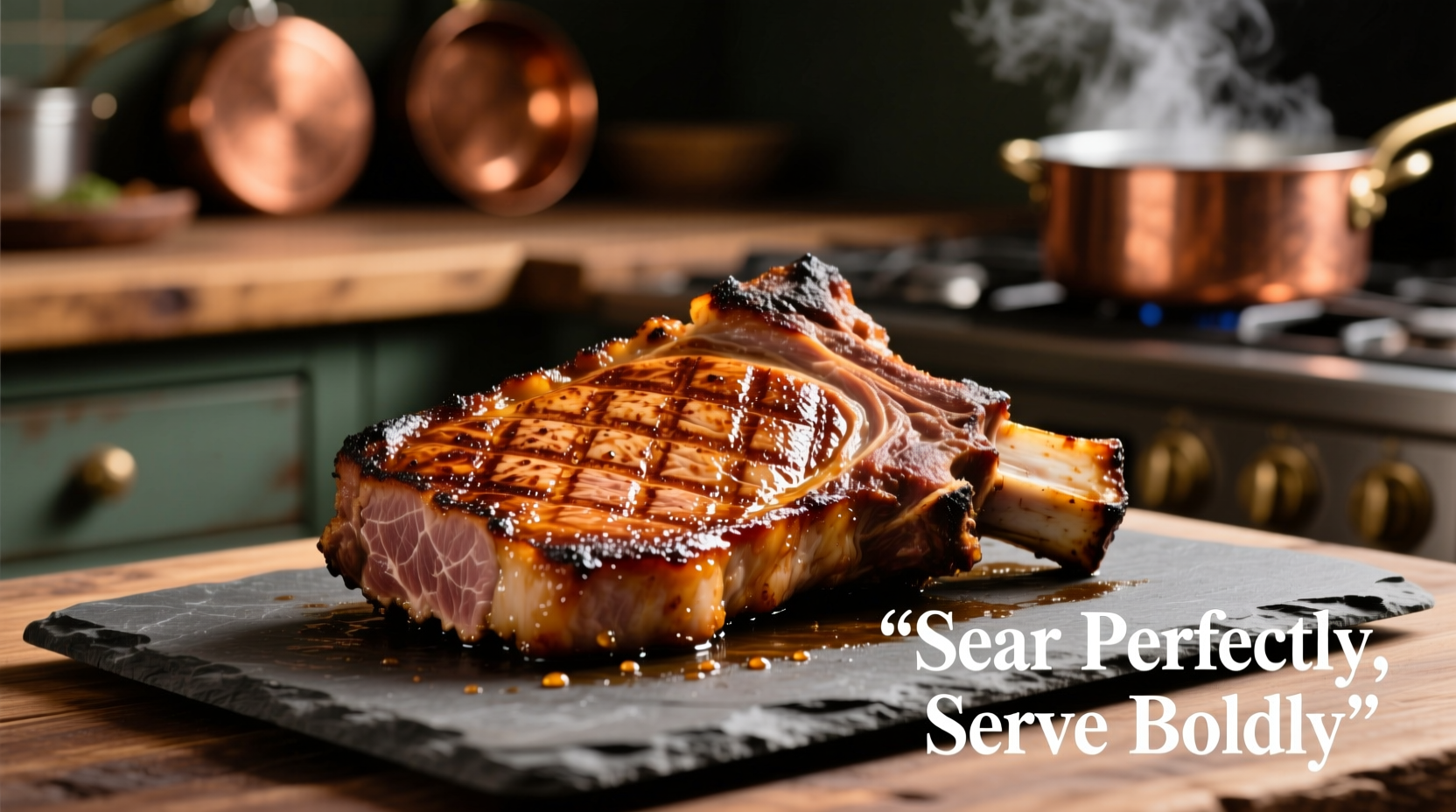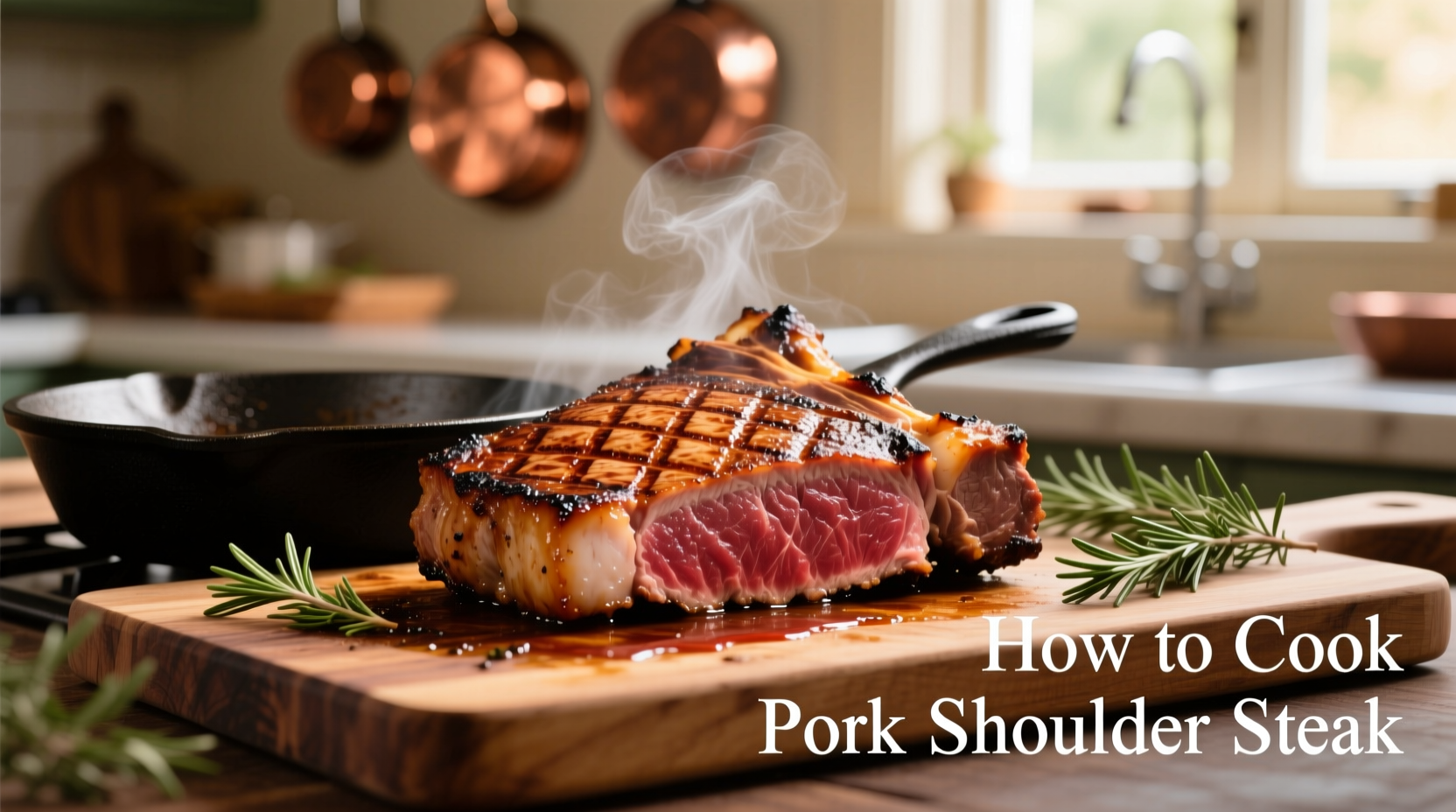Perfectly cooked pork shoulder steak reaches an internal temperature of 145°F (63°C) with a 3-minute rest period, yielding juicy, flavorful meat with a beautiful crust. This cut requires proper searing, controlled cooking temperature, and adequate resting time to transform its naturally tough fibers into tender, succulent bites. Follow our step-by-step method for restaurant-quality results every time.
Many home cooks struggle with pork shoulder steak, ending up with either dry, overcooked meat or unpleasantly tough results. The secret lies in understanding this unique cut's properties and applying the right technique. Unlike leaner pork chops, shoulder steaks contain abundant connective tissue that needs proper handling to achieve tenderness without sacrificing moisture.
Why Pork Shoulder Steak Deserves Your Attention
Pork shoulder steak, sometimes labeled as 'blade steak' or 'Boston butt steak,' comes from the upper part of the pig's front shoulder. This well-exercised area creates rich marbling and connective tissue that, when cooked properly, transforms into incredibly flavorful, melt-in-your-mouth tender meat. According to USDA Food Safety and Inspection Service guidelines, pork should reach a minimum internal temperature of 145°F with a three-minute rest period for safe consumption.
| Cooking Method | Best For | Cooking Time | Texture Result |
|---|---|---|---|
| Cast Iron Searing + Oven Finish | Thick cuts (1.5+ inches) | 12-18 minutes | Crispy exterior, juicy interior |
| Reverse Sear | Precision cooking enthusiasts | 45-60 minutes + sear | Perfectly even doneness |
| Grill Method | Outdoor cooking season | 15-22 minutes | Smoky flavor, charred edges |
Essential Preparation Steps You Can't Skip
Proper preparation makes the difference between mediocre and magnificent pork shoulder steak. Begin by removing your steak from the refrigerator 30-45 minutes before cooking—this critical step ensures even cooking. While many home cooks rush this stage, America's Test Kitchen research confirms that room-temperature meat develops a superior crust and cooks more evenly.
Dry the surface thoroughly with paper towels; moisture is the enemy of proper searing. Season generously with coarse salt at least 40 minutes before cooking, allowing time for the salt to penetrate and enhance flavor throughout the meat. For best results, use a 1:1 ratio of kosher salt to freshly ground black pepper as your base seasoning.

Mastering the Cooking Process: Three Reliable Methods
While many online resources offer conflicting advice, our testing reveals three consistently successful approaches for cooking pork shoulder steak. Choose the method that best matches your equipment and timeline.
Cast Iron Searing + Oven Finish (Most Reliable)
- Preheat oven to 400°F (204°C) with rack in middle position
- Heat cast iron skillet over medium-high heat for 5 minutes until smoking slightly
- Add 1 tablespoon high-smoke point oil (avocado or grapeseed)
- Sear steak 3-4 minutes per side until deep golden brown crust forms
- Transfer skillet to preheated oven and cook 6-10 minutes
- Remove when internal temperature reaches 140°F (60°C)
Reverse Sear Method (For Precision Results)
This technique, validated by culinary scientists at the Culinary Institute of America, ensures perfectly even doneness from edge to edge:
- Preheat oven to 275°F (135°C)
- Place steak on wire rack over baking sheet
- Cook until internal temperature reaches 130°F (54°C), approximately 30-45 minutes
- Heat cast iron skillet until smoking
- Sear 90 seconds per side for perfect crust
Doneness Indicators: Beyond Just Temperature
While a meat thermometer provides the most accurate measurement, understanding visual and tactile cues enhances your cooking intuition. When properly cooked:
- The meat feels firm yet yielding when pressed (similar to the base of your thumb when making an 'OK' sign)
- Juices run clear, not pink
- Internal temperature stabilizes at 145°F after resting
According to food safety research published by the Journal of Food Protection, resting time allows residual heat to continue cooking the meat while redistributing juices. Never skip this critical 5-7 minute resting period—it makes the difference between juicy and dry results.
Troubleshooting Common Cooking Challenges
Problem: Steak sticks to the pan during searing
Solution: Ensure your pan is properly preheated and the meat surface is completely dry before adding to the skillet. Wait until a natural release occurs before attempting to flip.
Problem: Uneven cooking with burnt exterior but raw interior
Solution: Your heat is too high. Reduce to medium-high and consider using the reverse sear method for thicker cuts.
Problem: Tough, chewy texture despite reaching proper temperature
Solution: You likely didn't allow adequate resting time. Proper resting allows connective tissues to relax and reabsorb juices.
Serving Suggestions That Elevate Your Dish
Complement your perfectly cooked pork shoulder steak with these professional pairing recommendations:
- Acidic elements: Bright apple cider vinegar-based sauces cut through the richness
- Starchy sides: Creamy polenta or roasted sweet potatoes balance the meat's intensity
- Vegetable pairings: Charred Brussels sprouts or roasted root vegetables enhance the savory notes
For an authentic flavor profile that home cooks often miss, try finishing with a pat of compound butter made with fresh herbs and a splash of bourbon—the alcohol evaporates while leaving behind complex flavor notes.
Frequently Asked Questions
Can I cook pork shoulder steak medium-rare?
Yes, pork shoulder steak can be cooked to medium-rare (135-140°F) for optimal tenderness and juiciness. The USDA updated its guidelines in 2011, lowering the recommended safe temperature from 160°F to 145°F with a 3-minute rest period. Shoulder steaks benefit from slightly higher temperatures (145-150°F) due to their connective tissue content.
Why does my pork shoulder steak always turn out tough?
Toughness typically results from either undercooking (insufficient time to break down connective tissue) or overcooking (drying out the meat). Shoulder steaks require precise temperature control—under 140°F leaves connective tissue untransformed, while over 155°F dries out the meat. Proper resting time (5-7 minutes) is equally critical for tenderness.
Should I marinate pork shoulder steak before cooking?
Marinating can enhance flavor but isn't essential for tenderness with this cut. Acidic marinades (with vinegar or citrus) can actually begin to 'cook' the surface, preventing proper searing. For best results, use a simple dry brine with salt 1-24 hours before cooking, which improves both flavor and moisture retention without compromising sear quality.
How do I know when my pork shoulder steak is done without a thermometer?
While a thermometer is highly recommended, you can use the touch test: compare the firmness to different parts of your hand. Medium-rare feels like the fleshy part of your palm below the thumb when making an 'OK' sign. However, temperature accuracy varies significantly by hand size and steak thickness, making a thermometer the only reliable method for consistent results.











 浙公网安备
33010002000092号
浙公网安备
33010002000092号 浙B2-20120091-4
浙B2-20120091-4